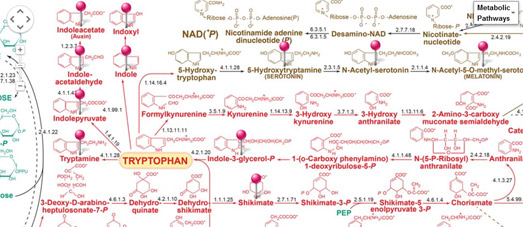Google Maps - the Body Edition

A metabolic pathway is a series of chemical reactions occurring within a cell. Each metabolic pathway consists of a series of biochemical reactions that are connected by their intermediates: the products of one reaction are the substrates for subsequent reactions, and so on.
You can now explore these metabolic pathways on a new Interactive Metabolic Pathways Map. The map, created with the Google Maps API, allows you to explore all the metabolites, enzymes, and selected pathways.
What is particularly impressive about this image map of the metabolic pathways is that it is fully interactive and searchable. You can select any of the carbohydrates, amino acids, lipids or purines & pyrimidines on the pathways map to learn more about its role in the metabolic pathway. You can also search for any of the features by name to quickly locate them on the map.

There has been a long tradition of using the Google Maps API to map the human body. One of the first examples was the NYU School of Medicine Virtual Microscope.
Created by the NYU School of Medicine the Virtual Microscope uses the Google Maps API to display and navigate scanned slides of microscopic images. Students and faculty members who are logged into the school's Learning Management System can even add markers to the slides to annotate and comment on slide features.

The University of New South Wales is following in this tradition by using the Google Maps to create maps of human tissue down to the individual cell. You can already explore the first map of human hip tissue.
This Google Map allows you to explore images captured with a scanning electron microscope. Creating map tiles from the electron microscope images allows the university to create an interactive map of the hip tissue. The result is this Google Map which allows researchers to pan and zoom into details in the microscope images, just as you can with any interactive map.

The Genome Projector is a searchable database browser that uses the Google Maps API to provide a zoomable user interface for molecular biology. The Genome Projector currently contains four views, the Genome map, the Plasmid map, the Pathway map, and DNA walk.
The Genome Projector says that "In molecular biology, looking at reactions and behaviors of specific molecular components in microscopic levels is important. ... Therefore, researchers need a scalable point of view, having access to all of the microscopic, macroscopic, and mesoscopic levels of biological knowledge. Moreover, biological data is highly multi-dimensional by nature, and understanding of the data requires multiple views, layers, or projections ..."


Comments